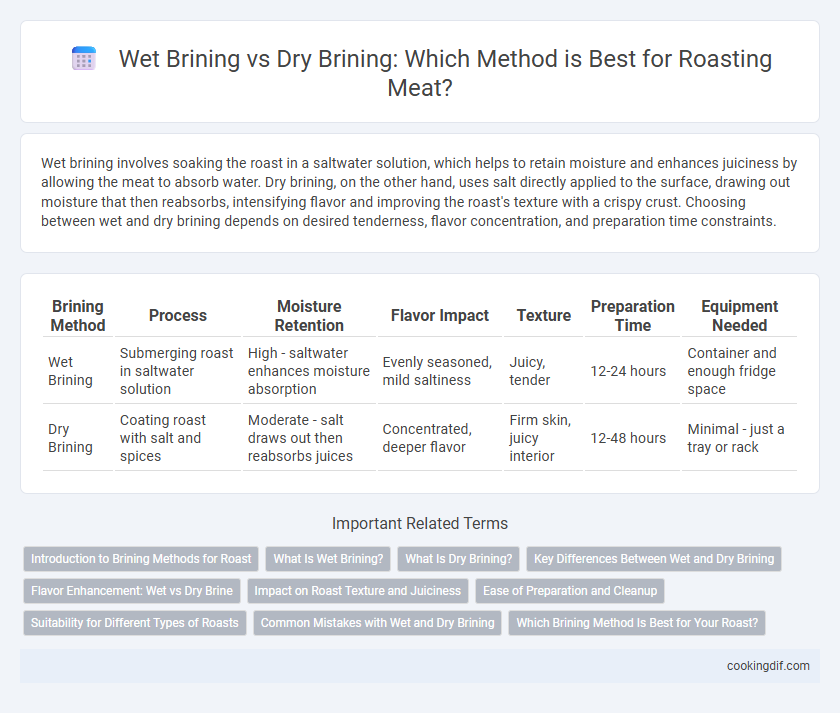Wet brining involves soaking the roast in a saltwater solution, which helps to retain moisture and enhances juiciness by allowing the meat to absorb water. Dry brining, on the other hand, uses salt directly applied to the surface, drawing out moisture that then reabsorbs, intensifying flavor and improving the roast's texture with a crispy crust. Choosing between wet and dry brining depends on desired tenderness, flavor concentration, and preparation time constraints.
Table of Comparison
| Brining Method | Process | Moisture Retention | Flavor Impact | Texture | Preparation Time | Equipment Needed |
|---|---|---|---|---|---|---|
| Wet Brining | Submerging roast in saltwater solution | High - saltwater enhances moisture absorption | Evenly seasoned, mild saltiness | Juicy, tender | 12-24 hours | Container and enough fridge space |
| Dry Brining | Coating roast with salt and spices | Moderate - salt draws out then reabsorbs juices | Concentrated, deeper flavor | Firm skin, juicy interior | 12-48 hours | Minimal - just a tray or rack |
Introduction to Brining Methods for Roast
Wet brining involves soaking the roast in a saltwater solution, enhancing moisture retention and seasoning throughout the meat. Dry brining uses coarse salt rubbed directly onto the surface, drawing out juices that then reabsorb, intensifying flavor and improving texture. Both methods improve roasting results by promoting juiciness and depth of flavor through different salt application techniques.
What Is Wet Brining?
Wet brining involves submerging the roast in a solution of water, salt, and often sugar and spices, which helps the meat absorb moisture and seasoning for enhanced juiciness and flavor. This method relies on osmosis and diffusion to break down muscle fibers, resulting in a tender and succulent roast. The extended soaking time allows the salt to penetrate evenly, making wet brining ideal for lean cuts prone to drying out during cooking.
What Is Dry Brining?
Dry brining involves salting the roast and allowing it to rest in the refrigerator for several hours or overnight, enabling the salt to penetrate the meat and enhance flavor and juiciness. Unlike wet brining, which submerges the roast in a saltwater solution, dry brining uses minimal liquid, helping to maintain a better crust during roasting. This technique improves moisture retention, tenderizes the roast, and intensifies natural meat flavors without diluting them.
Key Differences Between Wet and Dry Brining
Wet brining involves submerging the roast in a saltwater solution, which helps the meat retain moisture and enhances tenderness through osmosis. Dry brining uses a salt rub applied directly to the surface, drawing out moisture initially but then allowing it to reabsorb, intensifying flavor and creating a crispier crust. Wet brining typically requires more time and space, while dry brining is simpler and better suited for maintaining the roast's natural texture.
Flavor Enhancement: Wet vs Dry Brine
Wet brining enhances roast flavor by allowing salt and seasonings to penetrate deeply through a saltwater solution, resulting in a juicy and well-seasoned interior. Dry brining intensifies natural meat flavors by drawing moisture to the surface and reabsorbing it along with the salt, creating a concentrated, savory crust. Both methods improve taste but wet brining excels in moisture retention, while dry brining offers a more robust, caramelized exterior.
Impact on Roast Texture and Juiciness
Wet brining infuses the roast with moisture through saltwater absorption, enhancing juiciness and yielding a tender texture by breaking down muscle fibers. Dry brining intensifies flavor and improves crust formation by drawing out and then reabsorbing the roast's natural juices, resulting in a firmer texture with concentrated taste. Both methods improve roast texture and juiciness differently, with wet brining providing more moisture retention and dry brining offering enhanced flavor and crust quality.
Ease of Preparation and Cleanup
Wet brining involves soaking the roast in a saltwater solution, which can be time-consuming and requires a large container and extra cleanup due to liquid disposal. Dry brining, by rubbing salt directly onto the meat, offers a simpler preparation process and minimal cleanup since it doesn't involve additional containers or liquid waste. Overall, dry brining is more convenient for quick preparation and easier cleanup while still enhancing roast flavor and moisture.
Suitability for Different Types of Roasts
Wet brining enhances the moisture content and tenderness of lean cuts like turkey breast or pork loin, making it ideal for roasts prone to drying out during cooking. Dry brining, which involves applying salt directly to the meat's surface, is better suited for fattier roasts such as prime rib or pork shoulder, as it improves flavor penetration and creates a crispy crust. Selecting the appropriate brining method depends on the roast's fat content and desired texture, optimizing juiciness and taste.
Common Mistakes with Wet and Dry Brining
Common mistakes with wet brining include over-salting the solution, leading to an overly salty roast, and insufficient brining time, which can result in uneven moisture distribution. Dry brining errors often involve applying too much salt, causing a dry exterior, or neglecting proper resting time, which impairs flavor absorption and texture improvement. Both methods require precise timing and salt concentration to avoid compromising the roast's juiciness and taste.
Which Brining Method Is Best for Your Roast?
Wet brining infuses the roast with moisture and salt, enhancing juiciness and tenderness by allowing the meat to absorb a flavorful saline solution over several hours. Dry brining, which involves rubbing salt directly onto the meat's surface, intensifies flavor while creating a crispy, well-seasoned crust by drawing out and then reabsorbing the meat's natural juices. Choosing between wet and dry brining depends on your preference for texture and flavor intensity, with wet brining ideal for larger, lean cuts and dry brining preferred for quicker preparation and a concentrated, savory taste.
Wet Brining vs Dry Brining for Roast Infographic

 cookingdif.com
cookingdif.com